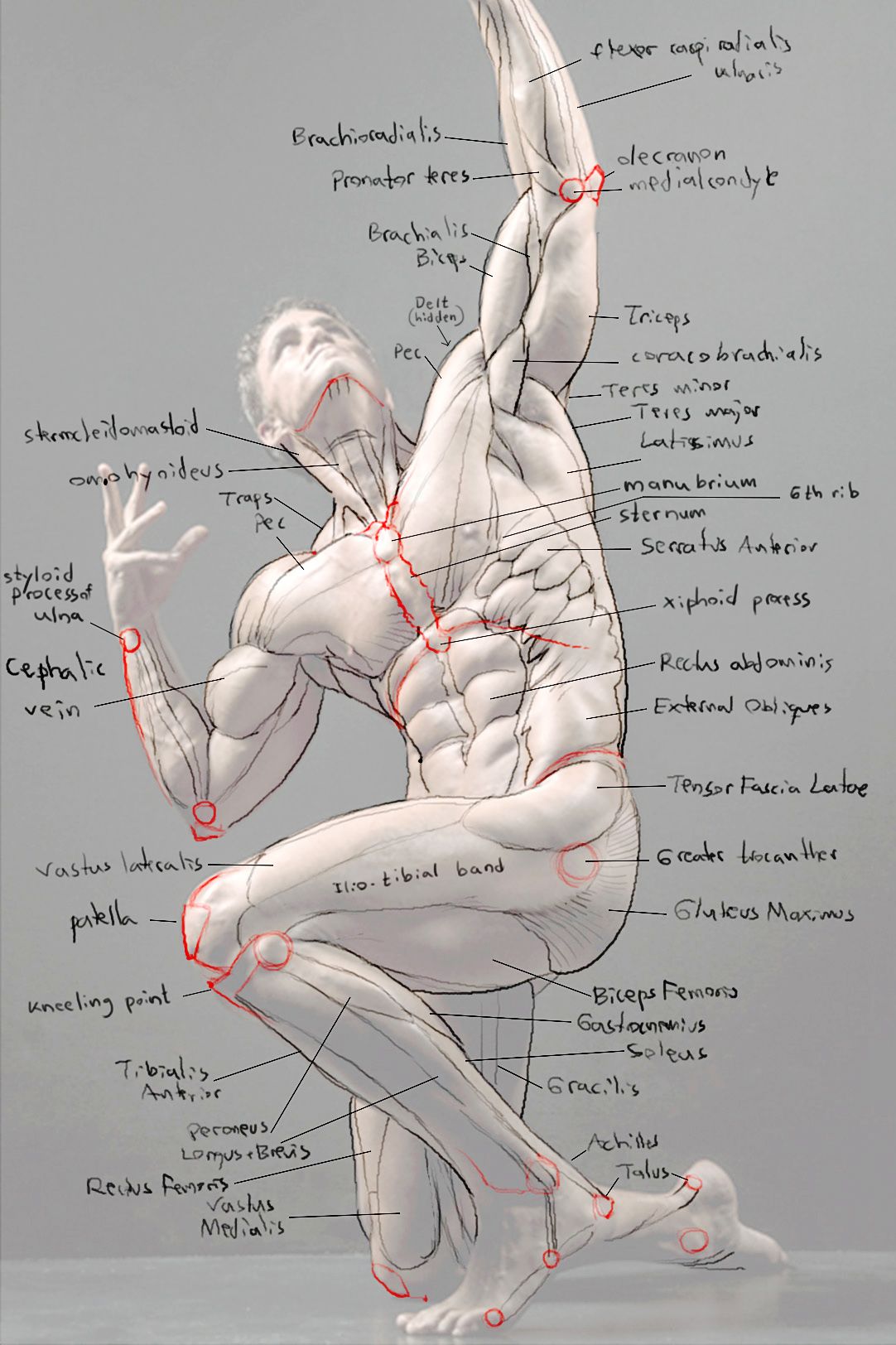Human anatomy for artists
Original photo sourced from the internet, for educational purposes only
Last year I went through Scott Eaton's 8 week course Anatomy for Artists
http://www.scott-eaton.com/anatomy-for-artists-online-course
I highly recommend this course, this guy really knows his stuff, he studied drawing and sculpture in Florence, which as you may know is the world capital of traditional academic art skills.
Here's some of what I learned from his course (bony landmarks in red). This is only front view but I'll try to do a back soon as well.
And also obviously only a tiny part of it, because Scott goes really in depth on everything, from the surface to the bones. With much more detail, for instance he tells you about the muscles holding your Metacarpals together. Plus he repeats everything many times, from different angles, and you get to do exercises... it's just great. :)

Some notes:
- Notice on the uplifted shoulder, that the Deltoid isn't visible, it's actually hidden behind the Pectoralis Major.
- There are 2 veins running down the Biceps, Cephalic and Basilic, I always get them mixed up but the one we usually see is the Cephalic one.
- The Brachialis sits underneath the Biceps, and is actually the larger of the two.
- The 6th rib is an important landmark because that's where the pecs end, and the Serratus Anterior starts.
- The outside of the thigh is another very complex and individually shaped area, due to how the Ilio-Tibial Band passes over both muscle groups Vastus Lateralis and Biceps Femoris, compressing them like a tightened belt. The surface form varies quite a lot between individuals, depending on the exact path and shape of the ITB, but also with pose, depending on which group is flexed or relaxed.
Using photographic or live reference, together with an understanding of underlying anatomy, and what is most commonly seen across a wide variety of individuals, is the best way to approach drawing human anatomy I think.
Feedback is welcomed and fervently hoped for! :)
do we need to know all that biological words too?
Yes, I know it seems daunting at first, I thought so too. But these are only the things visible on the surface. Doctors have like 10 times more names to memorize lol
And as I have to give feedback to the artists I oversee in my job, these names make it much easier and quicker to communicate exactly what I mean.
Once you see the logic behind them, they become easier. For instance, lateral which means side, lateralis is the muscle to the outside - while medialis sounds like median strip, and so it's logical that it means "towards the center line". Biceps means 2 heads, and so on. But for the bigger more common ones, yeah we do tend to just say pecs, delts, lats and traps. :)
What you say is very true, it's also important to understand how the body actually moves. Too many times i see comics, illustrations and concept art of people that couldn't actually move.
haha yes I know!
This post has received a 0.45 % upvote from @drotto thanks to: @banjo.
Congratulations! This post has been upvoted from the communal account, @minnowsupport, by Stahlberg from the Minnow Support Project. It's a witness project run by aggroed, ausbitbank, teamsteem, theprophet0, someguy123, neoxian, followbtcnews/crimsonclad, and netuoso. The goal is to help Steemit grow by supporting Minnows and creating a social network. Please find us in the Peace, Abundance, and Liberty Network (PALnet) Discord Channel. It's a completely public and open space to all members of the Steemit community who voluntarily choose to be there.
If you would like to delegate to the Minnow Support Project you can do so by clicking on the following links: 50SP, 100SP, 250SP, 500SP, 1000SP, 5000SP. Be sure to leave at least 50SP undelegated on your account.